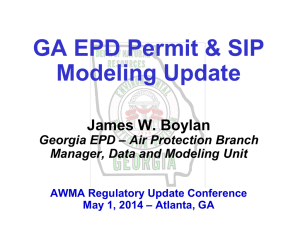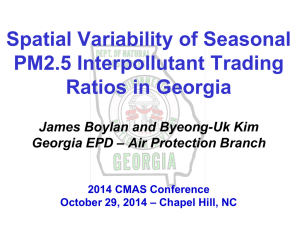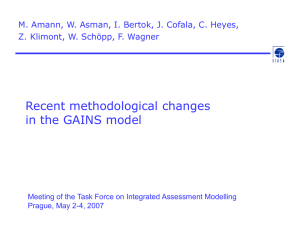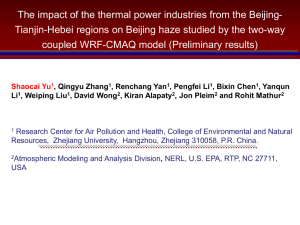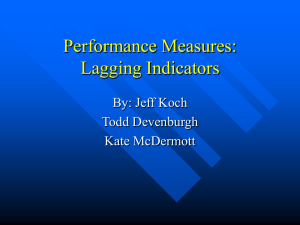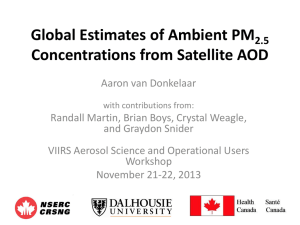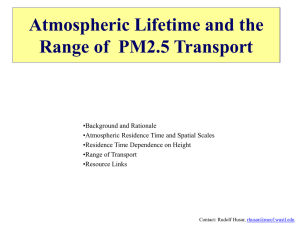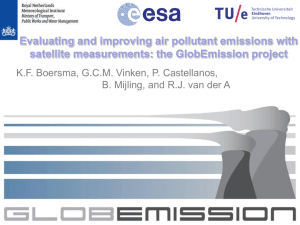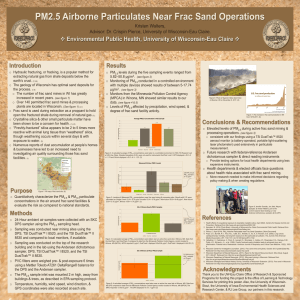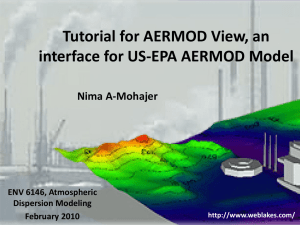20:1 - CMAS
advertisement
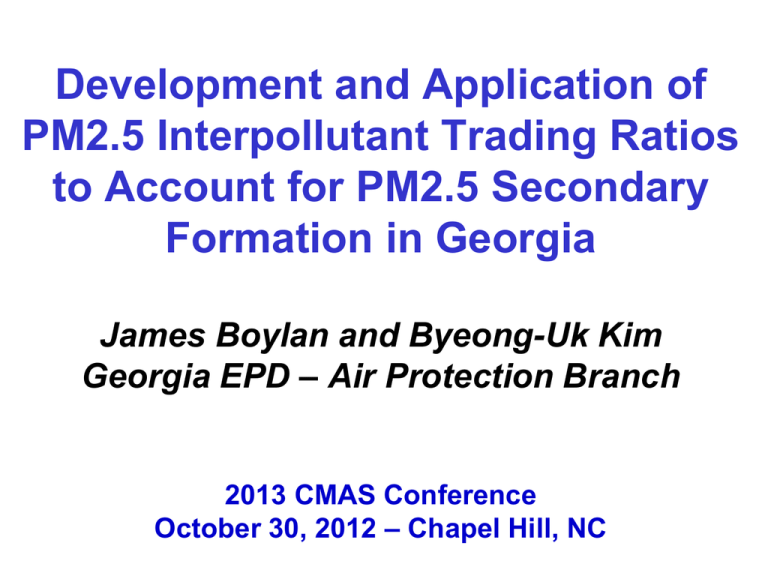
Development and Application of PM2.5 Interpollutant Trading Ratios to Account for PM2.5 Secondary Formation in Georgia James Boylan and Byeong-Uk Kim Georgia EPD – Air Protection Branch 2013 CMAS Conference October 30, 2012 – Chapel Hill, NC Introduction • Facilities applying for PSD air permits are required to model the impact of direct PM2.5 emissions (>10 TPY) using AERMOD. – In addition, these facilities must account for the impact of secondary PM2.5 formation from precursor emissions (NOx and/or SO2 > 40 TPY). • AERMOD does not contain chemistry or aerosol formation modules – The secondary formation of PM2.5 cannot be modeled directly in AERMOD. Interpollutant Trading Ratios • Sources applying for permits in areas designated nonattainment for PM2.5 can offset emissions increases of direct PM2.5 emissions with reductions of PM2.5 precursors in accordance with interpollutant trading ratios (also called “PM2.5 offset ratios”) contained in the approved SIP for the applicable nonattainment area. – For example, an existing source can increases PM2.5 emissions by X tons in exchange for reducing SO2 emissions by Y tons. Secondary Formation in AERMOD • PM2.5 offset trading ratios can be used to account for secondary formation of PM2.5 in AERMOD. • Convert SO2 and NOx emissions into “equivalent” direct PM2.5 emissions and model them in AERMOD – Option 1: Add SO2 and NOx “equivalent” direct PM2.5 emissions to the actual direct PM2.5 emissions and run AERMOD • Allows for ratios that vary temporally – Option 2: Calculate a percent increase in direct PM2.5 emissions due to the addition of SO2 and NOx “equivalent” direct PM2.5 emissions and scale the AERMOD output for actual direct PM2.5 emissions • Allows for ratios that vary spatially EPA Memo – July 21, 2011 The general framework for developing PM2.5 offset ratios would include the following steps: 1) Define the geographic area(s). 2) Conduct a series of sensitivity runs with appropriate air quality models to develop a database of modeled PM2.5 concentration changes associated with reductions of direct PM2.5 emissions and PM2.5 precursor emissions. 3) Calculate the interpollutant offset ratios for PM2.5. 4) Conduct quality assurance of the resulting ratios. Case Study: Georgia • Plant Washington – 850 MW Coal Fired Power Plant located in Washington County, GA • Final permit issued on April 8, 2010 • GA EPD used CAMx modeling to account for secondary PM2.5 impacts and ozone impacts from the proposed facility. Model Setup • MM5 for Meteorology – VISTAS 2002 • SMOKE for Emissions – VISTAS 2009 used in Georgia PM2.5 SIP – Added power plant emissions • 4200 TPY SO2, 1817 TPY NOx, 6 TPY EC • Stack height = 137.16 meters • CAMx with Flexi-nesting – 12-km/4-km/1.333-km • Three sensitivity runs to calculate baseline PM2.5 offset ratios – Zero-out stack emissions: SO2, NOx, EC CAMx Modeling Domains CAMx 12 km CAMx 4 km CAMx 1.3 km AERMOD D PM2.5 – Annual EC and SO2 Modeled PM2.5 Offset Ratios • Normalized Sensitivity (S) – SSO2 = (DPM2.5SO2/DTPYSO2) – SNOx = (DPM2.5NOx/DTPYNOx) – SPM2.5 =(DPM2.5PM2.5/DTPYPM2.5) • PM2.5 Offset Ratios (R) – RSO2 = SPM2.5/SSO2 – RNOx = SPM2.5/SNOx • Average the offset ratios as a function of distance from the source. Sensitivity Runs • Sensitivity runs were performed to evaluate how PM2.5 offset ratios varied by: – Distance from the source – Grid resolution – Season of the year – Stack height Annual PM2.5 Offset Ratios Distance from Source • Lower PM2.5 offset ratio values are more conservative (i.e., each ton of SO2 and NOx will produce more secondary PM2.5). • Select lowest ratio in each distance bin: Distance SO2 Ratio NOx Ratio < 1 km 30:1 70:1 1 – 4 km 20:1 50:1 4 – 10 km 10:1 40:1 > 10 km 7:1 35:1 RSO2 vs. Grid Resolution RNOx vs. Grid Resolution Impacts of Grid Resolution • Larger grid resolutions (e.g., 12 km) produce more conservative SO2 and NOx offset ratios (lower ratios) compared to smaller grid resolutions (e.g., 1.3 km) near the source. • Larger grid resolutions produce similar SO2 and NOx offset ratios compared to smaller grid resolutions far from the source. • Creating SO2 and NOx offset ratios using larger grid cells is a conservative approach. Quarterly SO2 Offset Ratios (DPM2.5PM2.5/DTPYPM2.5) RSO2 = --------------------------------(DPM2.5SO2/DTPYSO2) Quarterly NOx Offset Ratios (DPM2.5PM2.5/DTPYPM2.5) RNOx = --------------------------------(DPM2.5NOx/DTPYNOx) Impacts of Season of Year • SO2 and NOx offset ratios vary by season of the year and distance from the source: SO2 Ratios NOx Ratios Distance Q1 Q2 Q3 Q4 < 1 km 80:1 35:1 20:1 40:1 1 – 4 km 40:1 20:1 10:1 25:1 4 – 10 km 25:1 10:1 7:1 18:1 > 10 km 15:1 7:1 5:1 10:1 Distance Q1 Q2 Q3 Q4 < 1 km 250:1 50:1 50:1 120:1 1 – 4 km 160:1 35:1 35:1 120:1 4 – 10 km 80:1 20:1 20:1 N/A > 10 km 40:1 20:1 20:1 N/A RSO2 vs. Stack Height RNOx vs. Stack Height Impact of Stack Height • Stack height has a small impact on the SO2 offset ratios. • Stack height has a bigger impact on NOx offset ratios. • Shorter stacks have higher offset ratios, so using the lower offset ratios are conservative. • Taller stacks will be limited by GEP Stack Height Regulations, so we will not need to adjust the ratios. Tiered Approach • Use tiered approach starting with the most conservative offset ratios and easiest to apply: – Tier 1 • SO2 and NOx ratios from Q3 at d > 10 km – Tier 2 • SO2 and NOx ratios from Q3, vary with distance – Tier 3 • SO2 and NOx ratios by quarter at d > 10 km – Tier 4 • SO2 and NOx ratios by quarter, vary with distance Tier 1 SO2 Ratios NOx Ratios Distance Q1 Q2 Q3 Q4 < 1 km 80:1 35:1 20:1 40:1 1 – 4 km 40:1 20:1 10:1 25:1 4 – 10 km 25:1 10:1 7:1 18:1 > 10 km 15:1 7:1 5:1 10:1 Distance Q1 Q2 Q3 Q4 < 1 km 250:1 50:1 50:1 120:1 1 – 4 km 160:1 35:1 35:1 120:1 4 – 10 km 80:1 20:1 20:1 N/A > 10 km 40:1 20:1 20:1 N/A Tier 1 “equivalent” direct PM2.5 emissions from SO2 and NOx can be accounted for by scaling the standard AERMOD output files. Tier 2 SO2 Ratios NOx Ratios Distance Q1 Q2 Q3 Q4 < 1 km 80:1 35:1 20:1 40:1 1 – 4 km 40:1 20:1 10:1 25:1 4 – 10 km 25:1 10:1 7:1 18:1 > 10 km 15:1 7:1 5:1 10:1 Distance Q1 Q2 Q3 Q4 < 1 km 250:1 50:1 50:1 120:1 1 – 4 km 160:1 35:1 35:1 120:1 4 – 10 km 80:1 20:1 20:1 N/A > 10 km 40:1 20:1 20:1 N/A Tier 2 “equivalent” direct PM2.5 emissions from SO2 and NOx can be accounted for by scaling the standard AERMOD output files. Tier 3 SO2 Ratios NOx Ratios Distance Q1 Q2 Q3 Q4 < 1 km 80:1 35:1 20:1 40:1 1 – 4 km 40:1 20:1 10:1 25:1 4 – 10 km 25:1 10:1 7:1 18:1 > 10 km 15:1 7:1 5:1 10:1 Distance Q1 Q2 Q3 Q4 < 1 km 250:1 50:1 50:1 120:1 1 – 4 km 160:1 35:1 35:1 120:1 4 – 10 km 80:1 20:1 20:1 N/A > 10 km 40:1 20:1 20:1 N/A Tier 3 “equivalent” direct PM2.5 emissions from SO2 and NOx should be added to the actual direct PM2.5 emissions prior to running AERMOD. Tier 4 SO2 Ratios NOx Ratios Distance Q1 Q2 Q3 Q4 < 1 km 80:1 35:1 20:1 40:1 1 – 4 km 40:1 20:1 10:1 25:1 4 – 10 km 25:1 10:1 7:1 18:1 > 10 km 15:1 7:1 5:1 10:1 Distance Q1 Q2 Q3 Q4 < 1 km 250:1 50:1 50:1 120:1 1 – 4 km 160:1 35:1 35:1 120:1 4 – 10 km 80:1 20:1 20:1 N/A > 10 km 40:1 20:1 20:1 N/A Tier 4 “equivalent” direct PM2.5 emissions from SO2 and NOx will require scaling quarterly AERMOD outputs followed by recalculation of annual and daily PM2.5 impacts. Example PSD Application • Direct PM2.5 emissions = 118.30 TYP • SO2 emissions = 190.93 TPY • NOx emissions = 340.65 TPY • PM2.5 Scaling Factor = (SO2 TPY/SO2 Ratio) + (NOx TPY/NOx Ratio) + PM2.5 TPY PM2.5 TPY Distance Q3 SO2 Ratio Q3 NOx Ratio Scaling Factor < 1 km 1 - 4 km 4 - 10 km > 10 km 20 10 7 5 50 35 20 20 1.138 1.244 1.375 1.467 Annual PM2.5 – No Secondary Annual PM2.5 – Tier 1 Annual PM2.5 vs. SIL Daily PM2.5 – No Secondary Daily PM2.5 – Tier 1 Daily PM2.5 – Tier 2 Daily PM2.5 vs. SIL Summary • PM2.5 offset ratios can be used to account for secondary PM2.5 formation in AERMOD. • Tier 1 and Tier 2 approaches involve directly scaling the standard AERMOD output files. • Tier 3 approach involves scaling actual direct PM2.5 emissions prior to running AERMOD. • Tier 4 approach will require scaling quarterly AERMOD outputs followed by recalculation of annual and daily PM2.5 impacts. Contact Information Jim Boylan, Ph.D. Georgia Dept. of Natural Resources 4244 International Parkway, Suite 120 Atlanta, GA 30354 James.Boylan@dnr.state.ga.us 404-362-4851
